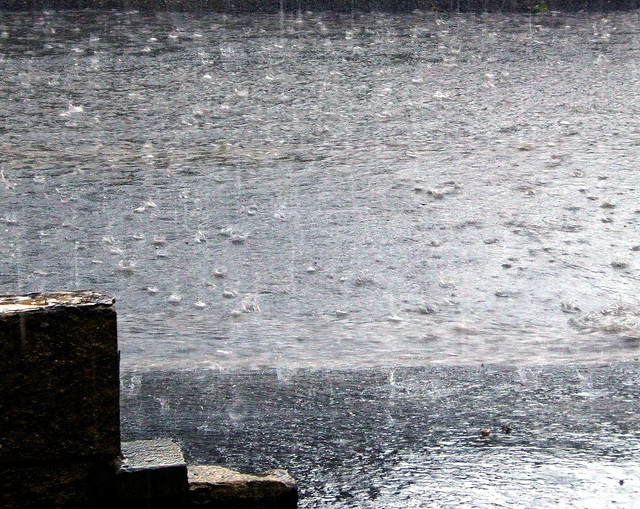“Could this have been the first weather warfare?”
February 18 Sixty-one years ago this week, devastating rain caused death and destruction in the English village of Lynmouth. Ryan Bachoo, 23, a Commonwealth Correspondent from Trinidad and Tobago, says the catastrophe may have been the result of human effort to manipulate weather.
Sixty-one years ago this week, devastating rain caused death and destruction in the English village of Lynmouth. Ryan Bachoo, 23, a Commonwealth Correspondent from Trinidad and Tobago, says the catastrophe may have been the result of human effort to manipulate weather.
Thirty-five people died and entire buildings by the dozens were destroyed when a severe flood struck the town of Lynmouth in England’s County Devon on August 15, 1952.
Nine inches (229 millimeters) of rain fell within twenty-four hours, causing the East LynRiver to rise rapidly and burst its banks. In fact, reports state the East and West Lyn Rivers “were swollen even before the fatal storm”.
“Trees were uprooted and formed dams behind bridges, creating walls of water that carried huge boulders into the village, destroying shops, hotels and homes. Bodies washed out to sea were never found,” said reports at the time.
“The air smelled of sulphur on the afternoon of the floods, and the rain fell so hard it hurt people’s faces,” survivors said. A BBC report 49 years later stated that 90 million tonnes of water swept destruction down the narrow valley into Lynmouth on the day of the storm.
Up until the 1950s, the world had been through many natural catastrophic disasters, but this one couldn’t be scientifically or naturally explained. North Devon experienced 250 times the normal August rainfall on that day in 1952. Survivors recalled the smell of sulphur, and called for investigation into rumours that planes were circling North Devon just before the ‘natural disaster’ occurred.
Could this have been the first ever successful experiment of weather manipulation, known today as weather warfare?
Weather warfare is the use of weather modification techniques like cloud seeding to increase rain or snow. But it’s not a today thing. It was used by the United States in the Vietnam War, when Operation Popeye used cloud seeding over the Ho Chi Minh Trail that increased rainfall by an estimated thirty percent during 1967 and 1968. The United States also dropped salt on the airbase during the siege of Khe Sanh in an attempt to reduce fog that hindered air operations.
Operation Cumulus involved a team of international scientists working with the Royal Air Force as they experimented with artificial rainmaking in southern Britain the week of Lynmouth’s catastrophic rainfall. A BBC investigation unearthed the words of those involved in the experiment, and the results were horrific.
Alan Yates, a glider pilot, tells how he flew over Bedfordshire as part of Operation Cumulus, spraying quantities of salt into the air. Scientists told him it caused a heavy downpour in Staines, 50 miles (80 kilometres) away in Middlesex.
“I was told that the rain had been the heaviest for several years, and all out of a sky which looked summery. The seedsman had said he’d make it rain, and he did. Toasts were drunk to meteorology. It was not until the BBC news bulletin was read later on that a stony silence fell on the company,” Yates said.
These practices were only the beginning of what is now a large-scale attempt by many around the world to use the weather as their next tank or rocket. Over the last 50 years, it’s turned from rainfall to trying to manipulate hurricanes, storms, tornadoes and worst of all, lightning.
To understand what weather warfare really is and how it works, it is best to take a walk back into history to make sense of how we got here, and most importantly, how seriously dangerous interfering with the weather can be. In the first of this two- part series, I’ll bring you the great mind behind weather weaponry while the second part will show staggering evidence that the weather on more than one occasion had been unexplainably manipulated.
Nikola Tesla was a Serbian-American inventor, electrical engineer, mechanical engineer, physicist, and futurist. He was the first man to think about controlling the weather. In the science world, he is known as the founding father of directed energy weapons. In his day, the late 1800s, he was regarded as Thomas Edison’s greatest rival. It was Tesla who invented alternating current that we use to power homes and appliances, and it was Tesla who set the path for controlling the weather. Perhaps his greatest theory was that of Extremely Low Frequency waves (ELF waves), which are electromagnetic radiation (radio waves) with frequencies from 3 to 300 Hz. These waves are so low that they are harmless to the human body. ELFs vibrate in our cars when music plays loudly, and even in our homes. Tesla theorized that if these Extremely Low Frequency waves can beamed out into the atmosphere, man can alter the weather.
Here’s how it works. Our atmosphere is made of the ionosphere, then the stratosphere, then the jet stream. Tesla theorized that waves beamed into the atmosphere would create heat, changing the molecular structure of the ionosphere, pushing it out into space. Then, the stratosphere moves up to the top, filling the space the ionosphere makes. Finally, the jet stream is forced to go up where the stratosphere usually is, altering the jet stream by hundreds of miles and the pressure within the atmosphere. The jet stream is important because it is only 50,000 to 60,000 feet up in the air and it moves billions of gallons of water around the world like a giant river above us.
When interfered with, the change in the jet stream can cause severe hurricanes, fatal storms, or crippling droughts. In the second part of this series, I’ll not only point out crucial unanswered questions when it comes to strange weather activity, but also explain why, while the public is now beginning to learn about weather manipulation, it may already be at our doorsteps.
photo credit: spratmackrel via photopin cc
………………………………………………………………………………………………………………
About me:
“Hi, my name Ryan Bachoo. I’m a Journalist and Public Relations Practitioner from PrincesTown in the twin island of Trinidad and Tobago. I’ve moved into the field of Mass Communication now. I currently work for the West Indies Cricket Board, protecting the online image of West Indies Cricket.
I’ve been a Broadcast Journalist at Cable News Channel 3 for three years. For the Commonwealth Youth Secretariat, I write on topics of politics, war and economics.”
Ryan Bachoo
Journalist & Public Relations Practitioner
The People’s Writer
I speak for those who have no voice!
…………………………………………………………………………………………………………………
Opinions expressed in this article are those of the author and do not necessarily represent the views of the Commonwealth Youth Programme. Articles are published in a spirit of dialogue, respect and understanding. If you disagree, why not submit a response?
To learn more about becoming a Commonwealth Correspondent please visit: http://www.yourcommonwealth.org/submit-articles/commonwealthcorrespondents/
…………………………………………………………………………………………………………………




